In the United States, 48 percent to 98 percent of illicit drug users smoke cigarettes compared to 19.8 percent of the general population. For those involved in treatment programs for addiction, there is some concern that treating smoking addiction at the same time as illicit drug addiction could impact the effectiveness of the core addiction treatment.
This hypothesis has been put to the test in a recent study, and the findings suggest that treating smoking addiction at the same time as addiction to stimulants such as cocaine and methamphetamine doesn’t affect the individual’s chance of remaining abstinent. The finding could prompt a shift in how rehab centers deal with people addicted to both nicotine and illicit drugs, but there is an important limitation that could impact how well the finding translates to real-world scenarios.
Studying Treatment For Those Addicted To Drugs And Cigarettes
 The researchers ran a randomized trial over the course of 10 weeks at 12 different substance abuse treatment programs between February 2010 and July 2012. The participants had to meet the diagnostic criteria for methamphetamine or cocaine addiction (or both), and also be interested in quitting smoking. The treatment for drug addiction went ahead as it ordinarily would for all participants during the study period, but they were split into two groups. In the first group, 271 participants simply received this “treatment as usual,” but in the second group, 267 participants were also given smoking-cessation treatment to see if it had an impact on their substance use outcomes.
The researchers ran a randomized trial over the course of 10 weeks at 12 different substance abuse treatment programs between February 2010 and July 2012. The participants had to meet the diagnostic criteria for methamphetamine or cocaine addiction (or both), and also be interested in quitting smoking. The treatment for drug addiction went ahead as it ordinarily would for all participants during the study period, but they were split into two groups. In the first group, 271 participants simply received this “treatment as usual,” but in the second group, 267 participants were also given smoking-cessation treatment to see if it had an impact on their substance use outcomes.
The smoking-cessation treatment consisted of counseling over the first 10 weeks of treatment along with the quit-smoking medication bupropion. After the fourth week, the group assigned to smoking-cessation treatment also received a nicotine inhaler to help with cravings. The researchers were mainly interested in how many participants in each group were abstinent from stimulants during each of the treatment weeks (confirmed by urine testing), but also looked at nicotine (and other substance) use as a secondary outcome, confirming smoking abstinence through a carbon monoxide breath test. The researchers followed up with the participants three and six months after the treatment period to investigate longer-term outcomes.
What The Smoking-Cessation Treatment Study Found
The results show that there was no significant difference in the number of weeks abstinent from stimulants between the two groups after 10 weeks, although the group that received smoking-cessation treatment averaged 77.2 percent of weeks’ abstinent from stimulants compared to 78.1 percent of those who just received treatment as usual. This isn’t a “significant” result because the difference wasn’t large enough to rule out random statistical fluctuations; in other words, the outcomes were the same.
It was also found that those who received the smoking-cessation treatment were considerably more likely to have quit smoking at any point during the 10-week trial period and throughout the follow-up. Given that this had no impact on overall stimulant-use outcomes over the 10-week period, the researchers suggest that smoking addiction can be treated alongside drug addiction without having a negative effect.
However, the results for abstinence from stimulants after the six-month follow-up were different. There was a significant difference in the number of drug-free days between the groups, with those who also received smoking-cessation treatment having had more drug-free days than those who just received treatment as usual. If anything, this suggests that concurrent smoking cessation and stimulant addiction treatment could have a benefit for both outcomes.
Limitations Of The Smoking-Cessation Treatment Study
The results may be promising, but there is an important limitation that could have an impact on the relevance of the findings. In the research, the smoking-cessation treatment included weekly counseling, a pharmacological treatment and nicotine replacement therapy. This is a full battery of stop-smoking treatments, and is unlikely to represent the level of stop-smoking care a drug addiction treatment facility could realistically provide. Additionally, a large percentage of participants were able to remain abstinent from stimulants, which may indicate that some other factor is making this study unrepresentative of real-world outcomes.
Treating Substance Abuse And Smoking Addiction Together Still May Be Helpfu
However, these are relatively minor criticisms, and the authors point out that other research (looking at treating alcoholism and smoking addiction together) has also shown that smoking-cessation treatment appears to have a positive impact on substance abuse treatment.
The core finding of this research suggests that treatment providers shouldn’t be opposed to drug users attempting to tackle nicotine addiction at the same time as their illicit drug problem, but more studies will be needed to see if this effect continues in more realistic scenarios.
Read More About If Addicts Can Make The Choice To Stop Using
If you’re contemplating addiction treatment, it’s probably not something you’re looking forward to. In fact, it wouldn’t be unusual if you’re completely dreading it and wish you somehow could avoid it altogether. But you can’t (for whatever reason) or you choose not to. So, it makes sense to do everything in your power to ensure that rehab is a one-time event and not end up having to repeat it down the road, right?
Of course, that’s much easier said than done. The road to recovery is replete with potential obstacles, some of which can be pretty daunting or so subtle that you don’t recognize them until it’s too late. Fortunately, though, the more aware and proactive you are throughout the process (i.e. before, during, and after rehab), the greater your chances of a successful, lasting recovery. Following are several ways to prepare for and avoid many of the most likely obstacles.
Prior To Rehab
Overcome the cost issue. There’s no doubt about it; addiction treatment often comes with a high price tag. Those daunting dollar signs can make you, like many who struggle with an addiction, feel that the treatment you need – and deserve – is simply out of reach. But before you throw your hands up in despair and reach for another drink (or hit), know that 1) you’re not alone, and 2) there are very likely options you haven’t yet realized.
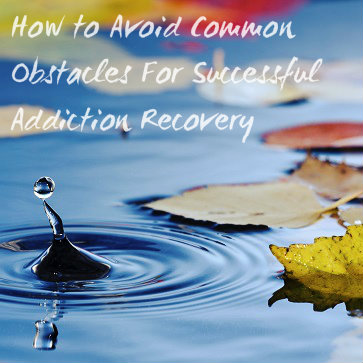 The first thing to do is check with your health insurance company (if you have health coverage) to find out exactly what they will cover. Many plans do cover addiction treatment to varying degrees. If you don’t have insurance, or if the coverage is very limited, then consider financing the program. Remember, this is a serious investment in your future, so don’t rule out financing it if needed.
The first thing to do is check with your health insurance company (if you have health coverage) to find out exactly what they will cover. Many plans do cover addiction treatment to varying degrees. If you don’t have insurance, or if the coverage is very limited, then consider financing the program. Remember, this is a serious investment in your future, so don’t rule out financing it if needed.
Many treatment facilities will allow you to set up a payment plan. Some offer financial assistance as well. Talk to the admissions department of the program or programs you’re considering to determine all the options available to you. You may find that the cost isn’t as prohibitive as it initially appeared, and that doors can open that you never expected. Don’t let the cost obstacle defeat you right out of the gate before you’ve looked into every possible option.
Another way to think of it: the cost of not getting treatment will almost certainly far exceed the cost of the most expensive treatment program in the long run – and often many times over. Many of those seeking treatment find that the old saying really does hold true: where there’s a will there’s a way. Have faith that a door will open if you knock on enough of them.
Avoid the wrong treatment program (for you) by being selective. Glossy brochures and fancy marketing tactics don’t necessarily mean a treatment center is good at what they do – or that it’s the right one for you. Do your research; check out the facility’s history, including staff credentials, licensure, etc. If possible, talk to anyone who’s received treatment there or who may be familiar with the program. Look for programs that are well-established, have a good reputation, and offer a comprehensive, holistic approach. Also, look for programs that offer good aftercare (more on that later).
It’s also important to make sure the program you choose offers treatment that’s based on research, rather than some “alternative” or trendy approach that may be lacking in substance even though it sounds really good on the surface. Extensive research has been done in the area of addiction treatment, and programs that base their treatment on scientific evidence are much more likely to be beneficial. Check to see if the program is properly accredited, which is a good indicator it’s approach is solid.
Make sure the program is a good fit for you. Some treatment centers have a specific philosophy (e.g. one that’s “based on Biblical principles”) or cater to a specific demographic (e.g. women only). You may thrive in a secular program but feel very uncomfortable in a faith-based rehab center – or vice versa.
You’ll be much more likely to succeed in rehab (and beyond) if you choose a program that fits you well the first time around. If you’re not sure, contact a few treatment centers and ask a lot of questions about their philosophy and approach. Keep in mind, though, that while none may feel like a “perfect fit”, one or two should feel like a better fit than others.
Along these same lines, it’s important to find a program that can accommodate any special needs you may have. For example, if you’re the sole custodian of your children, it would be a good idea to find a program that offers housing or other child care options for them while you’re in treatment.
During Rehab
Actively participate. Recovery isn’t something that passively happens to you – it’s something you actively work to achieve. You can go into addiction treatment kicking and screaming, sullenly determined to refuse to participate – and leave wondering why it seemed like a complete waste of time. Or, you can make the decision from the outset to actively participate and try to get as much out of your time there as you can.
Will it be fun? Probably not. Will it be worthwhile? That’s largely up to you.
Many addicts have a victim mentality, blaming everyone but themselves for their problems. Maybe your father was physically abusive while you were growing up, or your mother is an unbearable narcissist who finds nothing but fault with you. But while those experiences no doubt significantly impacted your life, they don’t have to define you. Now is the time to decide that your future is up to you and the choices you make from this day forward. The more you strive to get out of rehab this time, the less likely there will be a next time.
After Rehab
Regard your recovery as a long-term process. Successful recovery isn’t akin to a 100-yard dash. Rather, it’s much more like a marathon. Rehab may be a short-term, time-limited event, but it doesn’t end there. Yes, you did a lot of hard work while you were there – and it’s important to acknowledge that. But you didn’t walk out the door “cured” of your addiction. That’s why it’s imperative to continue using the things you learned in rehab if you’re serious about staying clean and sober.
Don’t let that discourage you. Remember, the most worthwhile things in life rarely (if ever) come quickly and easily. They take effort, tenacity, and determination.
Make sure you get proper aftercare. One of the most crucial aspects of successful recovery – and thwarting an early relapse – is proper aftercare. As mentioned above, recovery didn’t end when you left rehab. That would be nice, but it’s not reality. Many addiction treatment facilities offer ongoing aftercare to help ensure your success. However, if your rehab treatment occurs far away from home, it’s important to make sure a good aftercare plan is in place when you return home.
An aftercare program typically includes ongoing counseling and support. Support may come in the form of support groups (that you attend on a regular basis) as well as helping you establish a solid support network. Aftercare is crucial to your recovery because, without it, you are much more likely to relapse. It helps bolster you during times of temptation while keeping you accountable. Those who have a strong aftercare program are much less vulnerable to slipping back into their old habits – the very habits that contributed to their addiction.
Surround yourself with supportive people. You’ll encounter three types of people before, during, and after rehab: those who truly want you to succeed, those who want to undermine you, and those who don’t care one way or the other. The more you’re able to surround yourself with individuals in the first category, the greater your chances of staying on track with your recovery.
Sometimes supportive individuals (outside of those involved in your aftercare) are hard to find, especially if you don’t have supportive family or friends, have moved to a new city, or severely alienated everyone prior to rehab. But it’s not impossible with some effort. Twelve-step programs and other types of support groups are available in most areas. Online groups are also available, although they shouldn’t the replace face-to-face interactions that occur in support groups that you physically attend.
You can also find supportive individuals in a variety of contexts, such as a church community or an exercise-based program – any type of group in which people are more likely to endorse a healthy lifestyle and be supportive of fellow members. Talk to your aftercare counselor about ways to bolster your support network, as well as how to avoid situations and settings that may not be in your best interest.
Above all else, believe in yourself. You can either be your greatest cheerleader or your worst enemy. Ultimately, that choice is up to you. As someone in recovery, you may still be haunted at times by past pejorative labels. People may have been very cruel in the harsh words and judgments they directed towards you. And those can be hard to forget. But having an addiction doesn’t make you any less worthy than anyone else. Not to mention, choosing to get help, do the hard work, and continuing to work on your recover shows that you are resilient and courageous – two traits that should make you proud.
The recovery journey is anything but easy – anyone who says otherwise has never walked that path. The obstacles along the way can be overcome. Take it one step and one day at a time. Believe in yourself and you can and will succeed.
Check Out If Your Insurance Will Cover Your Rehab
When it comes to clinical depression, it’s typical to think of it as a disorder that largely affects women. However, men suffer from depression too, and it has the same profound impact on their mood, energy levels, and quality of life. Just as with women, it’s common for men with depression to abuse substances – particularly marijuana, stimulants and alcohol abuse – as a means of coping and alleviating symptoms.
While women are more likely than men to suffer from clinical depression [1], as many as six million American men experience symptoms every year [2]. Symptoms of depression in men sometimes don’t mirror those found in women. Research indicates that males may not always struggle with overwhelming sadness or excessive guilt. Instead, their symptoms more commonly include fatigue, anger, irritability, and sleep disturbances [3].
The Depression And Substance Abuse Connection
Depression and substance abuse frequently occur together. For example, it’s estimated that 40% of all people with depression struggle with alcohol abuse [4] – that’s a staggering statistic. Depressed men may also smoke marijuana, which can elicit feelings of relaxation and numb overwhelming negative emotions, like irritability.
While alcohol and marijuana are commonly abused, some depressed men abuse stimulants, like cocaine, speed, or prescription medications used to treat ADHD and narcolepsy. These drugs can produce a pleasurable high that can offset symptoms. For instance, a depressed man may take a stimulant medication, like Adderall or Ritalin, in order to find the energy to go to work.
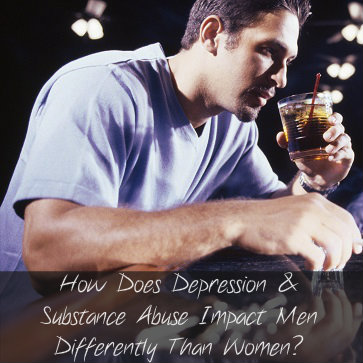 In some cases, depression symptoms appear before a substance abuse problem. Feelings of helplessness or worthlessness lead some individuals to self-medicate with substances. Initially, doing so seems to numb or relieve symptoms. However, in reality, many substances negatively affect brain chemicals linked to mood regulation. Many men drink or use drugs to feel better, sadly end up feeling worse. Rather than stop, he continues to drink or use in order to get high.
In some cases, depression symptoms appear before a substance abuse problem. Feelings of helplessness or worthlessness lead some individuals to self-medicate with substances. Initially, doing so seems to numb or relieve symptoms. However, in reality, many substances negatively affect brain chemicals linked to mood regulation. Many men drink or use drugs to feel better, sadly end up feeling worse. Rather than stop, he continues to drink or use in order to get high.
This vicious cycle can also start with substance abuse. In particular, depressant substances, such as alcohol, lower levels of serotonin. Serotonin is one of the chemicals in the brain that helps keeps mood stable. Over time, the alcohol abuse may actually trigger or contribute to symptoms of depression. Chronic stimulant use is also linked to depression. An addicted male will suffer withdrawal, usually marked by a range of uncomfortable symptoms which include depression.
Why Men Don’t Seek Treatment For Depression As Often As Women
In the U.S., women are diagnosed with depression as anywhere from two to four times more frequently than men [5]. This gap may stem from several factors, including:
Traditional ideas about men – Traditionally, emotional expression hasn’t been highly valued among males. Expressing sadness, frustration, or helplessness can be – and often is – seen as a sign of weakness or lack of discipline. A man may hesitate or refuse to seek depression and substance abuse treatment because he worries it will damage his masculinity. Preconceived ideas about men and substance use can play a role as well. For instance, having a few beers after work every night may not only seem normal, but also expected, especially if a man’s father or grandfather did the same.
Lack of knowledge – It’s likely that some men don’t seek treatment for depression or substance abuse because they’re simply not aware they have a problem. It can be easy to write off negative feelings as a temporary setback or a normal reaction to severe stress or a major loss. A man may believe that if he just keeps pushing forward his emotions will eventually stabilize.
Substance abuse can be hard to recognize as well. This is particularly true if he’s abusing prescription drugs. He may take them with the belief (or rationale) that they’re much safer than street drugs or okay to use just because they’ve been prescribed by a physician. Likewise, a depressed substance abuser may not realize that seemingly harmless and more acceptable substances like marijuana and alcohol can alter the brain over time and lead to an addiction.
Lack of motivation – Experiencing a lack of motivation is one of the many symptoms of depression. A person can feel as though he has no energy, making it a challenge to get off the sofa – much less seek professional help.
Stigma – Sometimes men won’t seek treatment because they want to avoid the stigma of having a “mental illness”. There’s stigma linked to substance abuse as well. It’s hard to ask for help when a man believes others will be quick to label him as an addict. Drug abuse, in particular, carries a strong stigma that potentially affects relationships and work.
The Importance Of Mental Health Treatment
Psychiatric disorders, like depression and substance abuse, require treatment just like any medical condition such as heart disease, diabetes, or cancer. Mental health conditions are complex disorders that have a number of causes, some of them biological in nature. Although it can be difficult to reach out for depression and substance abuse treatment, professional help is crucial and can be highly beneficial.
Co-occurring conditions have a significant negative impact on your life. For example, your relationships are probably suffering. There may be frequent conflicts with those you love. You may be unable to be the father you want to be to your children. Additionally, depression and drug or alcohol abuse affect sexual performance, which can further strain your relationship with a significant other or spouse.
Work performance is likely suffering, too. Substance abuse combined with depression may make you more prone to calling in late or sick. Frequent absences can have serious consequences. It can also be harder to perform assigned tasks and complete important projects, leaving them undone or forcing colleagues to pick up the slack. When workplace performance suffers, you’re less likely to hold onto a job and may have trouble finding a new one.
Depression and drug or alcohol abuse also adversely impact your physical and emotional health. For example, depression has been linked to a higher risk of heart disease in men [6]. Research suggests that men with heart failure who had moderate to severe depression were nearly four times more likely to die than those who weren’t depressed [7]. In addition, depression and substance abuse are both connected to a higher risk of suicide. It’s estimated that, overall, men are four to five times more likely to complete suicide than women [5]. This is largely due to the fact that males are more likely to use more lethal methods, such as shooting themselves.
Depression And Substance Abuse Treatment
If you have symptoms of depression and abuse substances, you need treatment. Contact a mental health professional or drug treatment facility that offers “dual diagnosis” treatment. If you’re not sure where to start, ask your primary care physician for a referral. Once you’re working with a mental health professional, be open about all symptoms and fully disclose your substance abuse habits. He or she will diagnose you and develop a treatment plan that may include residential or outpatient therapy, support groups, and, if necessary, medication.
Don’t let life fall apart because of your symptoms. Help is available. Reach out now for depression and substance abuse treatment to reclaim your physical and emotional health.
Read More About Depression And Drug Treatment
References:
[1] http://www.nimh.nih.gov/statistics/1mdd_adult.shtml
[2] http://www.apa.org/research/action/men.aspx
[3] http://www.apa.org/research/action/men.aspx
[4] http://www.niaaa.nih.gov/news-events/news-releases/national-survey-sharpens-picture-major-depression-among-us-adults
[5] http://www.ncbi.nlm.nih.gov/pmc/articles/PMC3140791/#!po=4.16667
[6] http://circ.ahajournals.org/content/early/2013/10/30/CIRCULATIONAHA.113.002065.abstract.html?ijkey=xgzTuA4JxivZbxO&keytype=ref
[7] http://newsroom.heart.org/news/depression-in-heart-failure-patients-233191
Who recognizes that they are enabling? Who enables so intentionally? And yet, if we have addicts in our lives, we must look carefully at how we interact with them. How do we handle a loved one with an addiction? The years of dealing with the addiction of a loved one blind us to our own actions and their consequences. Much of what we think is “helping” can actually be quite harmful.
Signs You Are Enabling
- Do you make excuses for the addict (e.g., lying to an employer to explain why the addict isn’t showing up for work)?
- Do you lie or deceive to protect the addict or your family’s image?
- Do you intentionally overlook bad behavior, saying that the addict “can’t help it?”
- Do you feel like you bear the brunt of consequences for the addict’s behavior?
- Do you continue to allow an addict son or daughter to live in your home despite substance abuse and his or her unwillingness to follow house rules?
- Do you loan or give money to the addict?
- Have you bailed the addict out of jail, or lied to protect him or her from getting in trouble with the law?
- Do you clean up the resulting mess? This can refer to the physical mess the addict makes during or after a binge as well as the messes he or she is making in life.
- Do you make his or her problems your responsibility?
- Are you trying to protect the addict from hitting bottom?
- Do you experience anxiety over the consequences the addict may experience as a result of his or her substance abuse?
- Do you excuse or overlook the addict’s words or actions when drunk or high?
- Do you feel guilty if you don’t help the addict?
- Do you do things for the addict that he or she can do for him or herself?
- Are you unable to say “no” to the addict?
- Do you live in fear of the addict?
- Are you constantly changing your plans to accommodate the addict’s antics, dramas and needs?
How Enabling Hurts Rather Than Helps The Addict
Enabling does not help or aid, rather it communicates the message that the addict’s actions have no consequences, or that if they do, someone (you) will be there to fix it, clean it up or excuse it away. If you are beginning to recognize enabling patterns in your relationship with the addict, know that it is not your fault. Life with a drug or alcohol addicted parent, spouse or child warps us. We are forced to find a means of coping with a situation that gradually grows more and more severe over time. In the beginning, a little helping isn’t an abnormal thing, but this helping subtly morphs, along with the addiction, into a full-blown condition.
What Can You Do Instead Of Enabling The Addict In Your Life?
What is the alternative? Letting go. And it will be painful to do. You may watch the addict lose jobs, get into trouble with the law, live in squalor, sink into poverty, and suffer all sorts of physical, mental and emotional discomforts. It will be as hard on you to watch as it will be for the addict to live through. You will want so badly to do something.
But when you do, you impede the addict from reaching that point at which he or she will become convinced of the need for a change, also known as “hitting bottom.” The longer you enable the addict and the addiction, the longer it will take the addict to pursue recovery. Get the support you need—either through Al-Anon, therapy or other support systems—and then call a halt to the cycle of enabling and addiction.
Learn How To Set Up A Safe Intervention For Your Addicted Loved One!
If someone you care about is beginning to find recovery in a 12-Step Program, you may find yourself with a lot of questions. Media images of 12-Step Programs are a caricature, and from the outside, we have to admit the practices look a little strange. Is this some sort of cult? Yes, you’re happy the addict is sober and getting help, but is this how it has to be?
What Are The 12 Steps All About?
The 12-Step Program was a program of recovery developed by alcoholics for alcoholics and other addicts. The program is based upon 12 steps that help the addict to come to grips with his or her condition and establish the kind of spiritual life that will be the basis of a solid recovery and sobriety. The program recognizes addiction as a disease—an allergy of the body and an obsession of the mind. The Alcoholics Anonymous (AA) premise is based on the understanding that if someone is addicted to a particular substance or behavior, he or she will never again be able to consume that substance or engage in that behavior in a normal or healthy way. Total abstinence is the only solution.
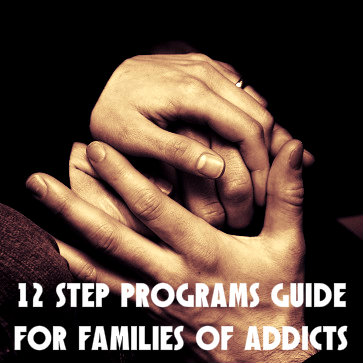 In most groups, members attend meetings regularly, read and study program literature, call and meet with other addicts or members in recovery and work regularly with a sponsor. Service to other addicts is of highest importance and seen as one of the keys to maintaining lasting sobriety.
In most groups, members attend meetings regularly, read and study program literature, call and meet with other addicts or members in recovery and work regularly with a sponsor. Service to other addicts is of highest importance and seen as one of the keys to maintaining lasting sobriety.
Aren’t 12 Step Programs A Little Overzealous?
It would appear that way to the outsider but, quite frankly, addiction is a little overzealous. For the non-addict it may be hard to fathom the prison and the punishment of being under the lash of a life-controlling addiction. As addicts, we have been so dominated by this cruel taskmaster that when we finally hit bottom we become willing to do whatever promises to rescue us.
And that proves to be quite a lot, as we soon find out once we’re in recovery. We believe that a powerful disease requires a powerful solution. In recovery we have to work as hard as the disease was working against us. But after a few years of sobriety many addicts come to see the program as the “easier, softer way,” when compared to the tyranny of addiction. When families see the beneficial results of program membership in their addict loved one, they too often become 12 Step supporters.
What Are The Roles Of Addict’s Loved Ones?
This will, to some degree, depend upon your relationship to the addict. For some recovering addicts, recovery needs to be a personal and private journey. They may not feel comfortable bringing others into their process, at least not in the beginning when they are yet fragile and convalescing. Don’t be offended by this; it isn’t personal. Recovery requires a lot of emotional work and some of us find we can better focus in the company of our program fellows, and perhaps apart from friends and family. Giving the addict the space he or she needs to heal can help to later guarantee closer relationships all around. Patience is needed.
It is wise, however, for the family of an addict to attend Al-Anon to learn more about the disease and how to deal with it. A family member’s addiction leaves scars on everyone. In Al-Anon you will come to better understand addiction, recovery and the 12-Step approach in addition to getting the support you need in healing from the wounds of addiction.
Read More On How 12 Step Programs Are Greatly Benefiting Teens
Everyone has heard of the functional alcoholic. This is the person who drinks excessively, who needs to drink every day to quell withdrawal symptoms, but who can also go to work, maintain relationships, and keep a home life that is fairly steady and balanced. Is it also possible to be a functional drug user? Is there a difference between a functional drug user and a drug addict? And how can you tell what is going on with your spouse?
The Functional Drug User
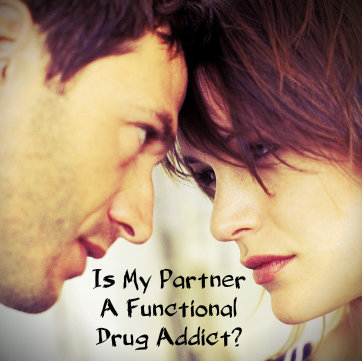 It is possible, at least for a time, for a drug user to be high functioning. If your spouse or partner uses drugs but still has a job, still meets your needs at home, still keeps up with responsibilities, and rarely experiences negative consequences related to drug use, your partner is functioning. Some of the most addictive drugs are difficult to use in such a way that functioning is still possible. For instance, heroin users are rarely functioning on any level other than a desire to get the next fix.
It is possible, at least for a time, for a drug user to be high functioning. If your spouse or partner uses drugs but still has a job, still meets your needs at home, still keeps up with responsibilities, and rarely experiences negative consequences related to drug use, your partner is functioning. Some of the most addictive drugs are difficult to use in such a way that functioning is still possible. For instance, heroin users are rarely functioning on any level other than a desire to get the next fix.
High-functioning drug users are more likely to be those that use marijuana, cocaine, prescription painkillers or amphetamines, or methamphetamine. If your partner uses drugs to get going in the morning, to relax after work, to cope with her emotions, particularly negative ones, or to get a boost of energy, she has a problem whether she is functioning or not.
Functioning And Addicted?
A functional drug user may not be an addict right away. If the drug use has not yet become compulsive or if your partner has not yet started to experience withdrawal symptoms, she may not yet be addicted. It is important to understand, however, that she is headed down a dangerous path.
If she continues to use drugs motivated by emotional reasons or the need to function during the day, she is headed down the path to addiction. Addicts can be high-functioning, and you may be watching your loved one gradually slide from casual drug use into addiction without noticing. The fact that she can function normally makes this transition difficult to catch.
Getting Help For Your High-Functioning Addict
It is very important for you and your partner to discuss her drug use. Whether you think she has become addicted or is still a casual user, she needs to stop using. Abusing drugs always carries the risk of addiction, no matter what her intentions are or how well she is functioning. No matter how strong-willed she claims to be about her drug use, it is possible that she will become dependent on her drug of choice.
Getting a functioning user to admit to having a problem is difficult. Denial runs deep in high-functioning addicts because they can always point to their lack of negative consequences to prove they don’t have a problem. If she lost her job, got in trouble with the law or was going broke feeding her habit, it would be easier to admit to having a problem.
Your job is to convince her that she is headed down a dangerous road, and that she may end up facing serious consequences if she keeps going; point to her motivations for using. Does she use drugs to cope with emotions she doesn’t want to recognize? Does she use because facing the day without drugs seems impossible? Does she need drugs to relax or to cope with stress? These are all the motivations of drug abusers and addicts. Help your partner to understand what she is doing and the possible harm it could cause in the long run.
Read About Functioning Addicts In The Media
Buprenorphine is an opioid narcotic medication used to ease a reliance on stronger narcotics during recovery from active drug addiction. For specific reasons, doctors often combine the use of this medication with a secondary medication called naloxone. In a study published in November 2013 in the journal Addictive Behaviors, researchers from the State University of New York, Buffalo explored the reasons some people successfully complete buprenorphine/ naloxone treatment for opioid addiction, while others do not.
Dependence Risks Of Using Opioids
All opioid substances produce two primary effects when introduced into the human body: a highly pleasurable (euphoric) mental state and a significant reduction in the ability to feel pain. Doctors rely on the pain-relieving effects of prescription opioids to relieve serious forms of pain, but must constantly monitor the possibility for the onset of opioid dependence and the subsequent development of an opioid addiction. Since illegal or illicitly used opioids produce the same basic effects as suitably prescribed opioids, intake of these substances also comes with serious dependence and addiction risks.
How Buprenorphine Is Used For Addiction
 Buprenorphine is a significantly less powerful drug than the popular legal and illegal opioids of abuse. When an opioid addict switches over to buprenorphine use, he or she commonly experiences a reduction in euphoric and painkilling sensations, and also gradually reduces his or her level of physical dependence on narcotics in general. Doctors take advantage of these qualities by prescribing the medication during opioid addiction treatment. Instead of facing intense, potentially overwhelming symptoms of opioid withdrawal during the early stages of the treatment process, patients who switch over to buprenorphine typically avoid withdrawal and set themselves up for an increased likelihood of long-term addiction recovery.
Buprenorphine is a significantly less powerful drug than the popular legal and illegal opioids of abuse. When an opioid addict switches over to buprenorphine use, he or she commonly experiences a reduction in euphoric and painkilling sensations, and also gradually reduces his or her level of physical dependence on narcotics in general. Doctors take advantage of these qualities by prescribing the medication during opioid addiction treatment. Instead of facing intense, potentially overwhelming symptoms of opioid withdrawal during the early stages of the treatment process, patients who switch over to buprenorphine typically avoid withdrawal and set themselves up for an increased likelihood of long-term addiction recovery.
In the U.S., the manufacture and distribution of buprenorphine (and all other legal and illegal opioids) are regulated under a federal law called the Controlled Substances Act. This law specifically stipulates that doctors who give their patients buprenorphine during opioid addiction recovery must also either provide access to some sort of therapeutic counseling or direct their patients to other counseling resources. The counseling options most commonly offered to individuals receiving buprenorphine are a reward/punishment approach called contingency management (CM) and a gradual behavior modification therapy called cognitive behavioral therapy (CBT). However, in reality, not all buprenorphine recipients end up participating in a counseling program, even when they have access to such a program.
How Naloxone Is Utilized With Buprenorphine
Naloxone is not an opioid drug. In fact, it was originally developed as an anti-opioid medication, and has the ability to rapidly halt the effects of opioid intoxication inside the body. Doctors use the combination of buprenorphine and naloxone to reduce the chances that a person going through opioid addiction treatment will abuse buprenorphine instead of using that medication as directed. When the two medications are dissolved together under the tongue, enough buprenorphine reaches the bloodstream to help relieve opioid withdrawal; at the same time, the presence of naloxone limits buprenorphine’s impact and reduces its usefulness as a target of drug abuse. A prescription medication called Suboxone contains the proper proportions of buprenorphine and naloxone to achieve the desired treatment objectives.
Buprenorphine/Naloxone Opioid Addiction Treatment
In the study published in Addictive Behaviors, the SUNY Buffalo researchers used an examination of 356 opioid-addicted adults to explore the factors that contribute to the successful completion of addiction programs centered on the combined use of buprenorphine and naloxone. All of these adults were enrolled in a six-month treatment course that provided access to counseling resources. 127 of the participants successfully completed the course, while the remaining 229 participants did not.
After assessing the impact of a range of potential factors, the researchers concluded that the individuals who successfully completed a naloxone and buprenorphine opioid addiction treatment differed from those who did not complete treatment in two key ways. First, they took advantage of the counseling resources made available to them and established good records of counseling attendance. Interestingly enough, they also had histories of previous, significant physical injuries.
The authors of the study published in Addictive Behaviors don’t know for sure why prior experience of a physical injury increases the chances that an individual will complete buprenorphine/naloxone-based opioid addiction treatment. However, they do have a potential explanation. Previously injured people may have a history of exposure to chronic pain; in turn, use of buprenorphine during addiction treatment may help relieve that pain in addition to decreasing a reliance on the addictive effects of stronger opioids. It is the combination of withdrawal avoidance and ongoing pain reduction that may account for the link between prior injury and successful buprenorphine/naloxone treatment outcomes.
Read More About Opioid Related Disorders And Break Free From Addiction!
10 Dec 2013
Are Current Drug Policies Really Not Working?
A report out of the United Kingdom highlights the widespread distribution of illegal street drugs, with the researchers calling the war on drugs a failure. The experts say it’s time to address drug use through a public health approach rather than as a criminal justice initiative.
Illegal Drugs – Stronger, Cheaper And More Readily Available
The study from the International Centre for Science in Drug Policy, which examined decades of drug surveillance data involving the trafficking of marijuana, cocaine and opiates like heroin, showed that illegal drugs are cheaper, purer and more available than ever.
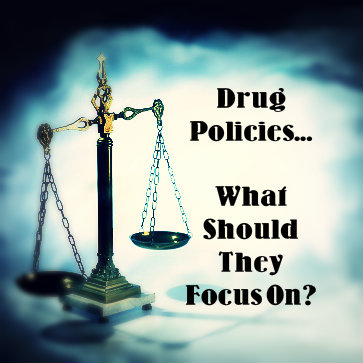 The findings highlighted the decrease of drug prices between 1990 and 2010, while purity and potency increased. In Europe the price of opiates and cocaine decreased by 74 percent and 51 percent during that time period.
The findings highlighted the decrease of drug prices between 1990 and 2010, while purity and potency increased. In Europe the price of opiates and cocaine decreased by 74 percent and 51 percent during that time period.
In addition, seizures of drugs increased during the study period. In most locations that were monitored the amount of cocaine, cannabis and heroin confiscated by law enforcement increased substantially during the years examined.
Should The Focus On Curbing Drug Use Shift?
The authors of the report note that the findings should be taken as an indication that current strategies to curb drug distribution are failing. However, despite these concerns, the focus for national governments has been law enforcement. Other approaches, such as decriminalization and legal regulation, have not been broadly incorporated.
Co-author Dr. Evan Wood, scientific chairman of the Centre, explained that the focus should shift to drug use as a public health concern rather than a criminal charge. Wood also talked about the need for increased addiction treatment availability and other public health strategies.
Just days before the findings were released, a senior UK police officer offered his opinion that decriminalization would be more effective than the current approach.
How Decriminalization Of Drug Offenders May Be A Positive Thing
Mike Barton, Chief Constable of Durham Police, voiced his position that drug users needed treatment and care, not criminal justice. Barton also said that decriminalization would threaten the motivation of dealers by taking away their income and power.
Instead, prohibition funds the drug dealers, says Barton, who is calling for an open debate that acknowledges the problems that still exist in the fight to reduce drug use.
Recovery Treatment Or Criminal Charges?
While the overall global strategy is prohibition, there are some national governments incorporating different policies. In Portugal individuals caught possessing drugs can avoid criminal charges if they undergo treatment.
While a more public health-focused approach seems clear to some in the scientific community, public officials have been less enthusiastic. No political party in the UK supports a legal regulation approach when it comes to hard drugs, but some politicians support legalizing marijuana.
Many recognize the delicate balance between treating drug use as a criminal justice issue and providing support for the recovery of the user. The community must be protected from the influence of the drug market, but the individual must be supported in their recovery, too.
Read More About Drug Use In The News



